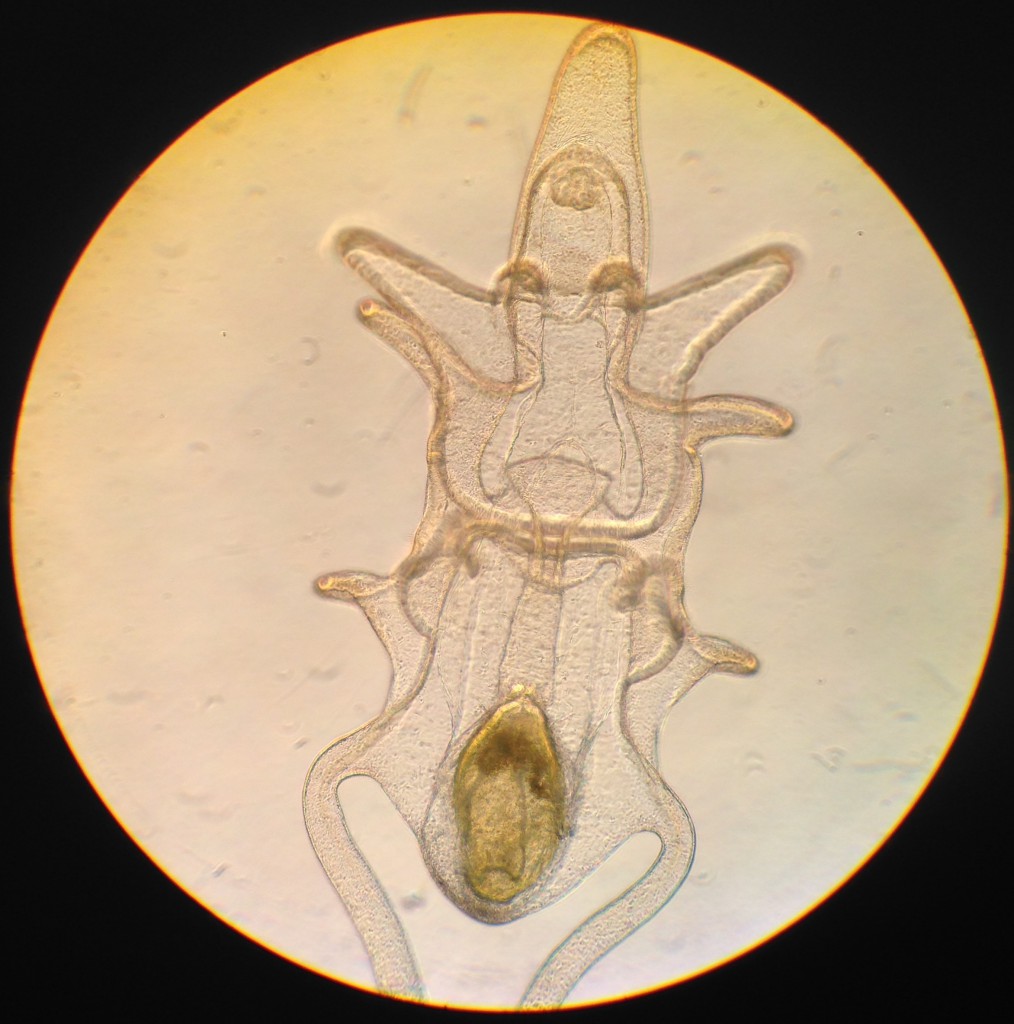I am astonished at how quickly my Pisaster larvae are growing and developing. This week saw their 3-week birthday, and today they are all of 24 days old. And look at how much they’ve changed since Monday!
This individual measures 1500 µm long, not including the length of those two long brachiolar arms on the posterior end. The main part of the body barely fits in the field of view under the lowest magnification of my compound microscope. Those long arms are very flexible, and today I observed that the animal reacts to sudden bright light by flipping them up towards the anterior end. The body can be scrunched into a surprisingly small ball, too, as I saw when I sucked it up into a pipet. Lacking the skeletal arm rods of the sea urchin’s pluteus larva, this brachiolaria’s entire body can be squished and flexed along any axis.
This video shows a little of how the brachiolaria larva moves around. I’ve trapped it under a cover slip in a large drop of water on a depression slide so it can’t swim away, but isn’t being harmed. If you look closely you can see how tiny food cells are swept along by the current generated by the ciliated band. This is a ventral view, so you are looking down on the larva’s front. The anterior end is to the left.
I’ve also been playing around with darkfield lighting, just because it’s fun. Everybody should do things just because they’re fun. Sometimes the fun stuff is also really cool:
While I had the darkfield lighting working I shot another video, this time focusing through various focal planes to show the three-dimensional structure a bit more. You can still see the food particles zooming around.
The next major developmental hurdle for me to look for is the formation of the juvenile rudiment. I expected to have another couple of weeks before rudiments would start forming, but given how fast things are happening I might not have much more time at all.
Why are these larvae developing so quickly? We know that development and growth rates for many marine invertebrates are temperature-dependent: both occur more quickly at higher temperatures. Surface seawater temperatures at the marine lab have been elevated for the past few weeks, hovering at 14-16.5°C for as long as these larvae have been alive. The warmer water increases metabolic rate, thus faster growth and development.
Is this a good thing or a bad thing? Well, that’s what I’m not sure of. My gut feeling is that it could be either, depending on food availability. One risk of higher metabolic rate is that the animal burns through its food supply more quickly. We can mitigate that risk by making sure that the larvae get fed every day and that their guts remain full at all times. Another risk of fast growth is the larvae could reach the developmental stage at which they could undergo metamorphosis, but not have had time to stockpile enough energy reserves to make it through the metamorphic process or survive long enough post-metamorphosis to grow the juvenile gut and begin feeding.
I can’t do anything about the elevated water temperatures, so will just have to wait and see what happens with these larvae.


